Media Archives
1994-2003 / 2004 / 2005 / 2006 / 2007 / 2008 / 2009 / 2010 / 2011 / 2012 / 2013 / 2014 / 2015 / 2016 / 2017 / 2018 / 2019 / 2020 / 2021 / 2022 / 2023
April 22, 2024
Las Vegas Weekly
Singer-Songwriter Bruce Cockburn Lands At Myron’s This Week
by Brock Radke
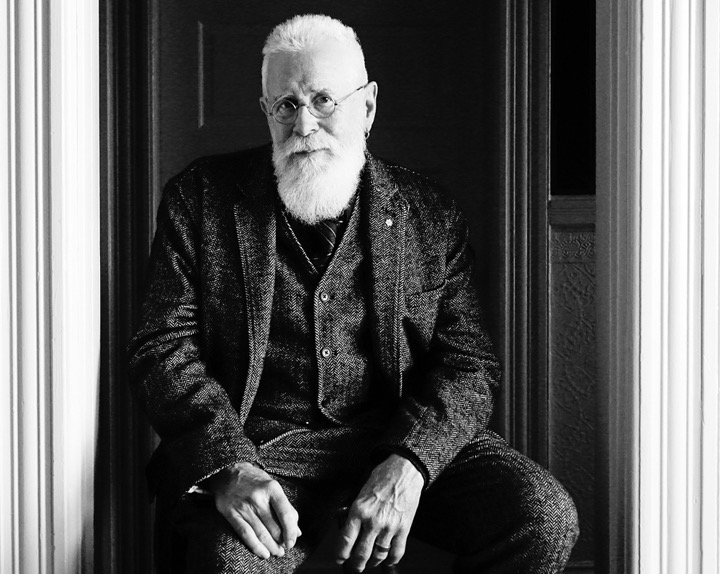
Local music lovers who follow the wonderfully distinct programming at Myron’s at the Smith Center are in for a rare treat this week when Canadian Songwriters Hall of Famer Bruce Cockburn makes a tour stop Downtown. The award-winning folk, jazz and rock artist—and remarkable guitar player—is making the rounds behind last year’s acclaimed O Sun O Moon, his 27th album which was recorded in Nashville with longtime producer Colin Linden.
It’s been long enough since Cockburn played Vegas that doesn’t remember where he played here last, but the 78-year-old legend remains a road warrior, recently finishing a series of shows in Italy. He’s toured Europe frequently during his long career, “and some aspects of those shows have been pretty politically charged,” he tells the Weekly. “When I started in Europe in the ’80s … it was very volatile in terms of street politics in those days, fascist terrorists blowing up train stations. It was kind of a wild scene.”
Cockburn is often categorized as a folk artist and his songwriting has frequently addressed human rights and environmental issues. But whether audiences are connecting to the meaningful lyrics or the articulate music, they are always connecting.
“It’s a whole different experience playing to an audience not fluent in English,” he says. “Some years ago a guy in Italy was telling me after the show, ‘I don’t understand anything you say, but I love your music because it makes me feel so calm.’ And that show included [songs] ‘Call it Democracy’ and ‘If I Had a Rocket Launcher,’ some fairly inflammatory stuff.”
The concert at Myron’s will be a solo show, just Cockburn and his guitar, “so if you don’t like a show that doesn’t have drums, don’t come,” he jokes. It may sound minimalist, but the uninformed should check out a live clip on YouTube to learn how Cockburn creates undulating layers of music all by himself, and hones in on his award-winning lyrics at the right moments.
“I’ve always felt free to write about any subject that came up … but people noticed the political songs early on and I was sort of defined that way in the minds of those people,” Cockburn says. “I don’t see that as being put in a box, but maybe what could be called a box is that I offer people songs where the lyrics matter. That approach … isolates me from a certain category of artist and a certain demographic, but lots of people want to be entertained by something that asks a little bit of them. That’s my crowd.”
Photo: Daniel Keebler
April 16, 2024
Grateful Web Interview With Bruce Cockburn
by Sam A. Marshall
In May 2023, Bruce Cockburn – the highly prolific Canadian singer-songwriter active as a performing and recording artist since the 1960s – released his 38th studio album, O Sun O Moon. Then, not long after that, he began an extensive tour in support of the album that – extending to nearly 50 dates so far – has continued into the present year.
Between late April and early July this year, Cockburn will be logging nearly 25 new shows of his soul-stirring live performances in the U.S. and Canada. And since those dates only cover a clutch of cities in the Southwest U.S. and in Ontario, it’s reassuring for those of us most mindful of the passage of time that the now-78-year-old artist is charting out another run of North American shows for late fall.
Practically on the eve of this next run of dates that begins on April 24, in San Luis Obispo, CA, Grateful Web was most fortunate to have a personal conversation with Dr. Cockburn about the record and upcoming tour. (This took place on April 9, coincidentally the day after the great 2024 North American total eclipse.) This highly-awarded songwriter and performer – and, in fact, a holder of three honorary doctoral degrees in music – touched upon some his personal creative processes, his way of looking at the world and even a bit of the mysteries of existence – all ingredients in the making of O Sun O Moon.
When I attended one of Cockburn’s shows last year in Cincinnati, Ohio, still early on the 2023 tour, O Sun O Moon was certainly the main entree of songs on the menu that night. Yet, there was a good number of recognizable, fan-favorite songs and a few surprises on offer. Over the year since the album’s release and beginning of the tour, faithful fans of the master musical storyteller and guitarist have had a chance to become more deeply familiar with the new album. And – to my ears and mind at least – it may very well become as cherished as any of his most classic collections.
Although I was introduced to Cockburn’s music in the later 1970s, not long after his first few albums had been released, I’ve admittedly drifted in and out through different stages of his career. While I was off following other genres and more rock-oriented artists, I’d keep my ear cocked for what ‘progressive’ folk artists such as he and British folk-rock pioneer Richard Thompson would be up to next, even if l didn’t always listen to every album in depth. Initially more of an solo acoustic folk songwriter, he pursued a more obvious electric route with backing bands in the ‘80s, and in the MTV era even reached beyond his core audience with videos for such electrified rock activism songs as “Call It Democracy” and “If a Tree Falls”. Of course, some of that period drew me back. Yet, I’ve surely missed a good many things, so even now I feel as if I’m still catching up with Cockburn.
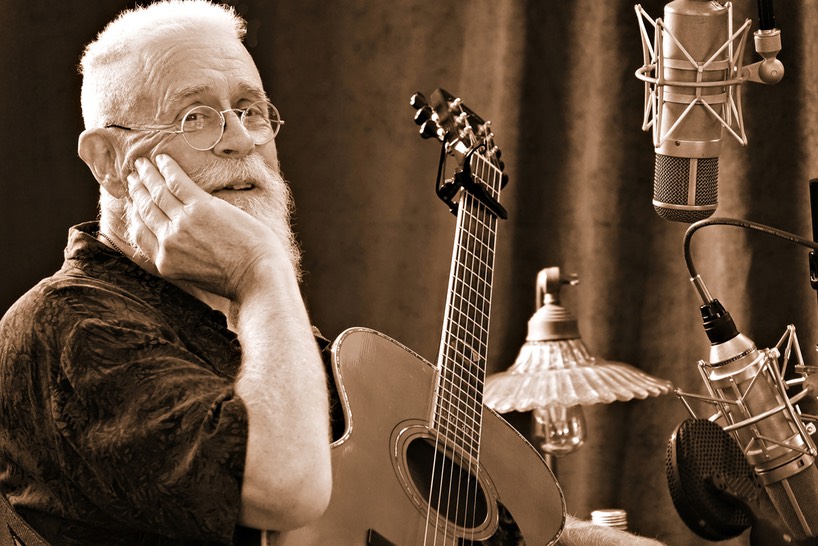
With my incomplete knowledge of Cockburn’s entire body of work, I’ve tended to gravitate toward his more rock-oriented releases, and a personal favorite is his 2002, You’ve Never Seen Everything. This album deftly balances ballads against some modern-rock grooves such as the rap-spiel opener “Tried and Tested”. And while there are moments of sweetness and light in the folk-style songs, there are more experimental moments, too, like the album’s title track – a chilling, nine-minute, film-noir-soundscape with spoken-word narration that takes the listener on a journey through a dark night of the soul. I also tend to listen more for his instrumentals and expressive, jazz-flavored guitar performances than for his lyrical songs, so I’ve also been highly impressed with his all-instrumental albums, 2005’s Speechless and 2019’s Crowing Ignites, which are both journeys of their own.
Recorded in Nashville with Cockburn’s go-to producer Colin Linden, O Sun O Moon seemingly reshuffles the deck on listener expectations – and mine. It’s an album of sublimely crafted acoustic songs, rich in musical textures, air, and light that never once leave one wishing for more electrical current. Through alternating modes of quandary, gravity, celebration, sardonic humor and emotional resolve, his poetic and minimalist lyrics explore questions of life and mortality, love and forgiveness, and our place in the world.
So, yes, personal themes abound on the album, such as making the best of the time one has left in life (“On a Roll”), the spirituality in everyday life (“Into the Now”) and looking ahead to the next adventure (“When You Arrive” – a joyous New Orleans’ waltz that not only serves as the album’s grand finale but is also a rousing live sing-along.)
In any case, the longtime social and political activist also hasn’t shied away from contemporary issues but allows them a space of their own on the album. One such song is the percolating, roots-y, climate-change tune, “To Keep the World We Know”, which he co-wrote with fellow Canadian singer-songwriter Susan Aglukark. And in the probing song about coming to terms with our fellow man and woman titled “Orders”, the perennial humanitarian seemingly answers the biggest question of all – “Why are we here?” – with unflinching directness.
Front and center, of course, is Cockburn’s warm and knowing but not-always-sweet voice, swathed in musical textures that range from soothing and inspirational to ones with more spit and grit. In fact, you might think that his song “King of Bolero” is a fair impression of Tom Waits. His guitar playing is also exemplary, although it never draws undue attention to itself. And both his vocals and instrumentation are kept good company with a fine ensemble of guest vocalists and musicians. Among these are Gary Craig, Sarah Jarosz, Jenny Scheinman, Buddy Miller, Susan Aglukark, Shawn Colvin and Jim Hoke.
O Sun O Moon is a satisfying emotional experience, from start to finish, and if you’re a longtime fan of this veteran songwriter, then you have very likely already moved it upward – if not all the way to the top – on your personal list of favorite Cockburn albums. If you happen to be still largely uninitiated to his musical universe, then this album – with its Zen-like sense of presence, sage wisdom and timelessness – is an excellent place to start your journey.
“One more time,” Cockburn urges his backing singers onward with a glimmer in his voice on the final, life-affirming refrain of “When You Arrive.” And when he plays it live, the whole audience joins in, shedding even more light into all the dark corners. Now isn’t that what friends are for?
GW: Glad you could make time to talk to us, Bruce. Our phone call seems very timely, since your recent album is called O Sun O Moon, and yesterday we had the total eclipse in the eastern U.S. A nice coincidence! I’m guessing that maybe if you’re near the East Coast right now, you were able to see the eclipse. If you did, I’m curious what your personal reaction to the that was.
Cockburn: Yes, in fact, I’m in Ontario at the moment. It was pretty amazing, actually.
GW: We enjoyed it in our area, too, and we could travel to where totality was without too much effort. Coincidentally, you often deal with imagery of stars and the cosmos in your lyrics, so one of the things I wanted to ask you about is the struggle between darkness and light in your songs. The album title and lyrics of O Sun O Moon seems to allude to that, but then you have a song like “On a Roll”, which seems to imply that maybe the light is winning this time. Would you say that’s true, or is it still always shifting for you?
Cockburn: That’s an interesting question. I haven’t exactly thought about things from that angle. My songs come from a pretty personal place, so, in my mind, they don’t automatically equate with larger philosophical observations. But, to phrase that question another way: “Do I feel myself to be an optimist or a pessimist?” In those terms, then I do tend to go back and forth.
In certain areas, in terms of individual spirituality, I’d say I’m an optimist. But in regard to the future of the planet, I’m more inclined to pessimism. The pessimism isn’t [giving in] and saying, “Ahh, what the hell! It’s all going down. . . .” It’s because I have grandchildren and also a young child, and I worry about the future for them.
The pessimism comes in where I don’t see as much being done to offset the threats that we’re faced with. Spiritually speaking, I do think there’s a kind of contest between dark and light, and I think that “On a Roll” is a celebration of the fact I feel like – at least while I was writing that song – that light will triumph. Also, that when I cross that boundary to whatever comes next, I’m gonna find myself in a good place. That’s what the hope really is.
GW: That’s good. An interesting thing about the new album is your sense of resolve in the lyrics. Thinking back to your [2011] album, Small Source of Comfort, I sensed that you were in a period of doubt and transition as a songwriter. After that you did one more lyrical album, Bone on Bone, and then next was the all-instrumental album, Crowing Ignites. So did the instrumental album serve as a kind of ‘palate cleanser’ for you, to give you a break from writing lyrics?
Cockburn: I suppose it could have had some of that effect. I had wanted to do a Speechless II, and the original Speechless was a compilation of previously recorded instrumental pieces from my various albums. So my intention was to write a few new instrumentals to go with the same concept, because I had recorded a lot of other instrumentals since the first Speechless came out. And we might still do that someday. But what happened is that once I started writing the pieces, they kept coming and I ended up with a whole album of new stuff that became Crowing Ignites.
So, yes, it was cleansing, and, perhaps, I also didn’t have so many pressing lyrical ideas at the time. It was fun to make an instrumental album and to think only in those terms. When it comes to writing lyrics, I can’t really force the issue very well. I’ve done it occasionally, and I haven’t liked the results very much. But with instrumental music, I can just pick up my guitar, start fooling around and look for things more actively than I can with lyrics. So it was fun to work on Crowing from that perspective.
GW: I do think there’s often a quality in your albums of forward motion, kind of a restless search. In a certain sense, some might consider that ‘progressive’. One of the things I get from O Sun is more of a contented feeling, maybe even a nostalgic flavor. Obviously, you reference your own sound. But it also seems as if you might be giving some stylistic nods to some of your formative influences, such as the Gypsy Jazz of Django Reinhardt and Stéphane Grappelli. With the accordion, vibes and violin, there are also hints of Astor Piazzolla and New Orleans blues and jazz. Would you say that this new album came to you more freely than some of your recent projects?
Cockburn: I guess I’d have to think back to what some of the other albums were like to work on, but this one worked out very smoothly. As I said, when writing lyrics, I wait around for ideas and for the ‘flash’ and little ‘gooses’ of energy that get it going. And when that happens, I’m very grateful.
Several of the new songs were written in Maui when some of my family, friends and I were there [a couple of summers ago]. We rented a house, and it was so calm with tranquil, beautiful surroundings, and good company. That was, of course, before the tragic fires in Lahaina. The effect of that atmosphere was like it popped the cork and out came all of these songs!
For example, two songs that were like that were “King of Bolero” and “Into the Now”. Another song, “Colin Went Down to the Water”, came about a little differently but also in that setting. There was – as I like to think of it – a certain amount of grace that went into the writing of the songs, very little conscious tugging at things to get them to happen.
The oldest song of this set of songs was “When You Arrive”, and the idea for that had sat around in my notebook a long time. Then, one day, it suddenly clicked, and I thought, “Oh, yeah!” And that’s how it works. I’ve had that experience with songs, from time to time. It’s not like I went back to them every day and said, “What I can do with this?” They’re just there, and then something would invite me back to revisit them, and then there it was. Whether all of this was easier than other albums, I’m not sure. I’d have to think back hard about how those songs came to be.
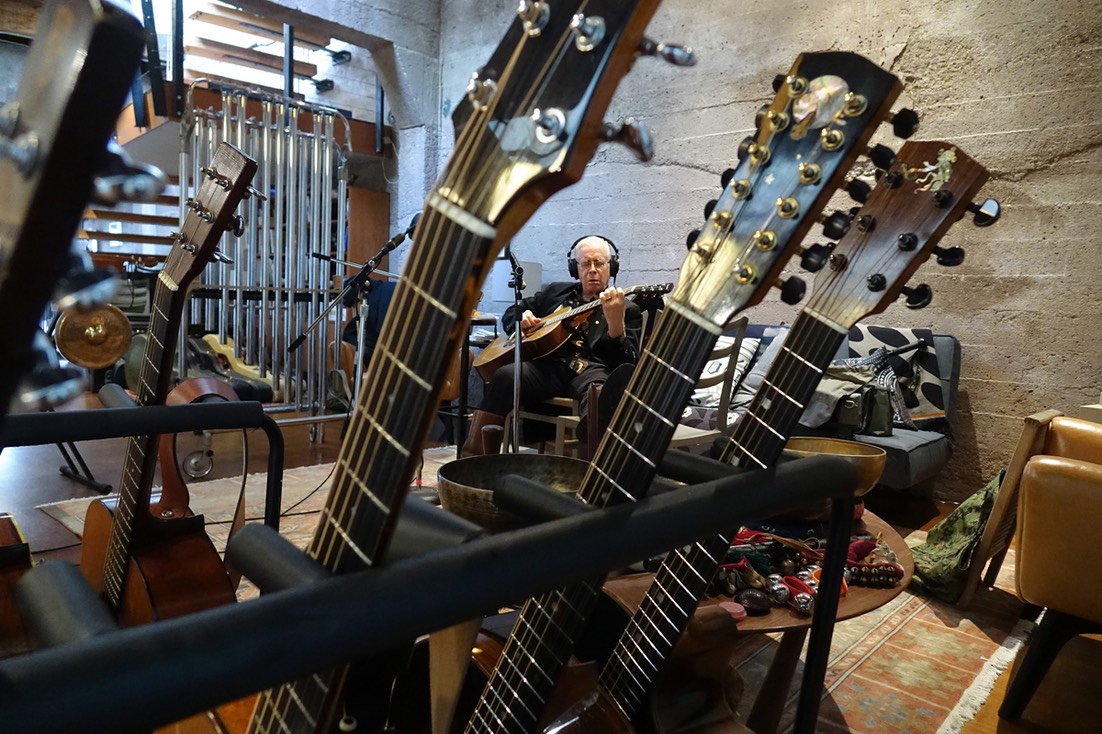
Even the recording [of O Sun]went pretty well, and that can sometimes be more difficult than the songwriting. One thing on this session is that I suffer from Meniere’s Disease, and my vertigo acts up at times. I’d have attacks of vertigo every day during the recording, and yet it came out all relaxed and cool. And – heh-heh – you won’t hear that on the record. We got lucky with that. It could have been worse! But, it was a very pleasant atmosphere at the studio where we recorded in Nashville. I stayed in a house where you walk across the yard, and then you’re in the studio. It made it all very workable and fun.
The way we approached it was that Gary Craig –my drummer and percussionist – and I recorded everything together. So he acted like a kind of human beatbox or human click-tracking, and he kept me in the right place rhythmically. So we had vocals and guitar, and some form of drums or percussion, and then we added people to that. And the great thing about it for me, in particular, is that I didn’t hang people up [during the sessions] waiting for me to get my shit together. And everybody contributed the most beautiful things.
Jim Hoke, the horn [and clarinet] player, walked in, really prepared, and he did the most amazing and beautiful horn parts. He started laying stuff down, and it was really magical, even though I was feeling like garbage.
GW: I’m glad you mentioned that. I wanted to ask you specifically about the horn, vibes and violin arrangements and how much of that you pre-composed. From what you say, it definitely sounds like you gave the musicians a blank page.
Cockburn: Yes, I’ve always taken the approach that you hire somebody based on the fact that you like what they do. So I just see what they’re going to do. And if something isn’t working, then I’ll intervene and say, “OK, how about more of this, or less of that?” But, generally, with the calibre of people we’ve had coming in, that hasn’t been much of an issue.
Sarah Jarosz came in and sang and played great. And (violinist/vocalist and previous Cockburn collaborator) Jenny Scheinmann – we got lucky with her, because she just happened to be in Nashville at the same time. We had no budget to fly people around. We had to use people we had access to, and Jenny was someone I’ve worked with a lot in the past.
GW: Yes, I saw her warm up and perform with you in Michigan in 2011, so I know just how good she is.
Cockburn: There was a lot of magic like that around the making of the album, and a lot of really good feelings.
GW: Briefly, I’d like to have you touch upon your own musical training and education. For example, I know you studied jazz guitar at Berklee School of Music early in your career (mid-1960s). Just curious whether you always approach your songwriting from a theoretical perspective, or, for example, if you like to experiment and create new harmonies using altered tunings?
Cockburn: I do use some different tunings, although for a long time I didn’t. Way back near the beginning, I did use ‘open C’ and that’s the tuning I use on “Soul of a Man” (Note: This is a song that Cockburn has been performing on his recent tours). I learned that song in the ‘70s from the Blind Willie Johnson record. But I had observed the tuning from watching the Reverend Gary Davis. But other than that, I steered away from using open tunings back in the early days because I was hearing a whole lot of people who really couldn’t play guitar using those tunings to make the songs sound different from each other. And – heh – that didn’t work very well as that kind of function.
So I didn’t want to get stuck in that. For me later on, that ceased to be an issue and I just started exploring other tunings. That’s especially evident on Crowing Ignites. And there’s a song on this new album that’ s in what I call “E-GAD”. It’s DADGAD (six-string) tuning with the low string left in E instead tuned down to D. That gives you a nice combination of fourths and modal harmonies that you can move with, kind of like [jazz pianist] McCoy Tyner. Y’know, I’m not comparing what I do with what he did. .
GW: Right. I understand, though, that you’re augmenting your harmony by changing the chord voicings. . .
Cockburn: Yeah, and it applies on some other songs, like the “King of the Bolero”, “When Push Comes to Shove” and maybe another one. Sometimes, all you have to do is change [the tuning of] one string, and then that suggests some new kind of riff that you hadn’t stumbled on before. And that can become the basis for a new song.
GW: As I’ve seen from setlist.fm – if that website is at all reliable, your sets over the last year have remained fairly fixed since the start, with a focus on O Sun O Moon and a pretty consistent selection of your other historical songs. I’m curious whether you’ve been writing any new songs in this period and trying any of them out live, and whether you feel like another album is possibly taking shape.
Cockburn: Not really. . .I'm not ruling out the possibility of doing another album. I’ve just been busy doing what I’m doing, and the energy that might have gone into songwriting – some of that’s gone into figuring out new ways of doing songs that my arthritic hands won’t do very well now.
Songs that I’m doing are the ones that people would want to hear. I had to come up with a new way of playing “All the Diamonds in the World”, for instance, and “Pacing the Cage” and a couple of other things that people are always asking for. For a long time, I’d have to say, “No, sorry, can’t do it because my hand won’t make those chord shapes. And that’s one area where using alt tunings can be very helpful.
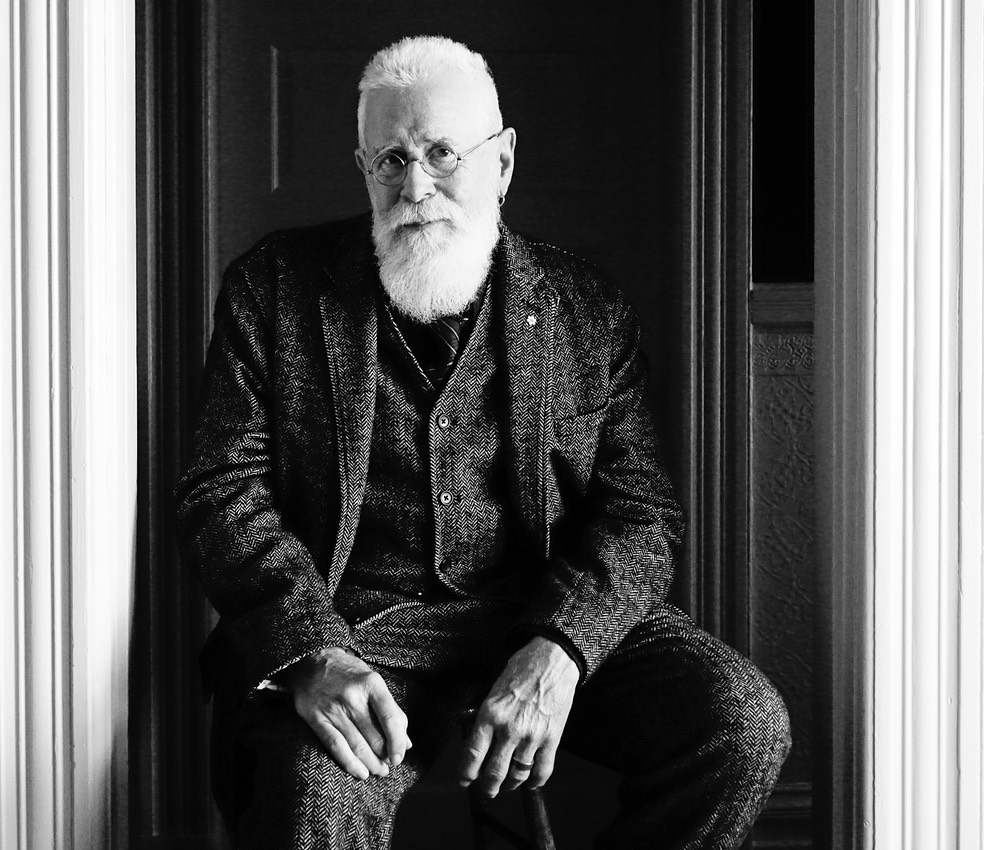
So, I’ve been doing some of that [re-arranging] and that’s been taking up some of the songwriting energy. But it’s worked, and I’m able to play those songs now. Whether people approve of the change in my guitar [parts], I don’t know. There are a lot of guitar players who’ll come to the shows, and they’ll see that those aren’t the same shapes they’ve seen me do before. But I think the music works now, and hopefully they’ll think so too!
GW: As you were writing O Sun O Moon, life was obviously going on all around us. Global warming, for example, is obviously a big modern problem that you call out in the album, and you alluded to other things such as the Covid period of 2020-2021. So do you like to be more indirect now in your observations or do you still like to be blunt, as you were with “All Our Dark Tomorrows” or “Trickle Down” (Two overly political songs from You’ve Never Seen Everything.)?
Cockburn: I think it depends on the circumstances and what kinds of ideas come to me. I don’t have any specific ‘policies’ about that. It’s just what comes up. Susan Aglukark approached me about co-writing a song. And her idea about “To Keep the World We Know” was about global warming, and that song was much more intentional than I usually am. It’s because another person was involved, and it was her idea. Not the title, but she had some phrases and the concept. She wanted us to write a song about wildfires. I kind of took the ball and ran with it, and then we tossed its back and forth – over the phone, by email, etc. – and we came up with that song. I think it worked out well, but that’s quite specific and pointed.
In terms of what the song’s talking about, it doesn’t name people. But the problem [of global warming], of course, is bigger than just calling out people’s names. To single out certain decision makers for a song like that would be pointless, because they’re all screwing it up. Who’s your ‘bad guy’ today? The ‘bad guy’ is the money interests that are financing our politicians and financing their policies. That’s hinted at in the song, but that’s the enemy and it’s how we handled it.
GW: Touching on your repertoire in more detail, I wanted to ask you a bit more about your fans’ expectations. You mentioned before that fans ask for songs, but you’re not always able to play them now, even if you want to. Which songs from your history do you enjoy playing the most, and which ones, if any, would you like to ‘retire’?
Cockburn: Ohhhh, there’s – heh-heh – um, I don’t think I’d necessarily want to name specific songs. But, really, not because I don’t like the songs, but when I’m thinking of putting a show together, there’s always a short list of songs that have to be in the show. And sometimes I find that kind of confining. So it would be nice to just not do them. For a while, anyway, and have them come back later.
In a way, that happened with “All the Diamonds”, “Pacing the Cage” and “Lord of the Starfields”. They’re all songs that because of the [chord] fingering of the original versions, I could sort of play them, but they didn’t come out well. They were all sort of messy sounding. So I had to come up with new ways of playing, and that made them fresh again.
Having to not be able to play them for a couple of years, at least — it’s been about that long that I’ve had this problem. So people would call out especially for “Pacing the Cage” and I’d really [regret] not being able to do it. I’d say, “I’m really sorry, but I’m working on it.” So that was one that got a rest and then it feels to play it again – feels good. With “All the Diamonds”, I did go through a phase where I hated that song – not as a song, just having to play it. But that was years ago, and I got over it.
Some [older] songs are lighter and they don’t require quite as much from me to perform them. I don’t have to go quite as deep to perform them as I do with “Pacing the Cage”, y’know, to make them meaningful in performance. I’m happy I got a rest with “Pacing” because it’s not a happy song, and I have to go back to where I was emotionally when I wrote the song.
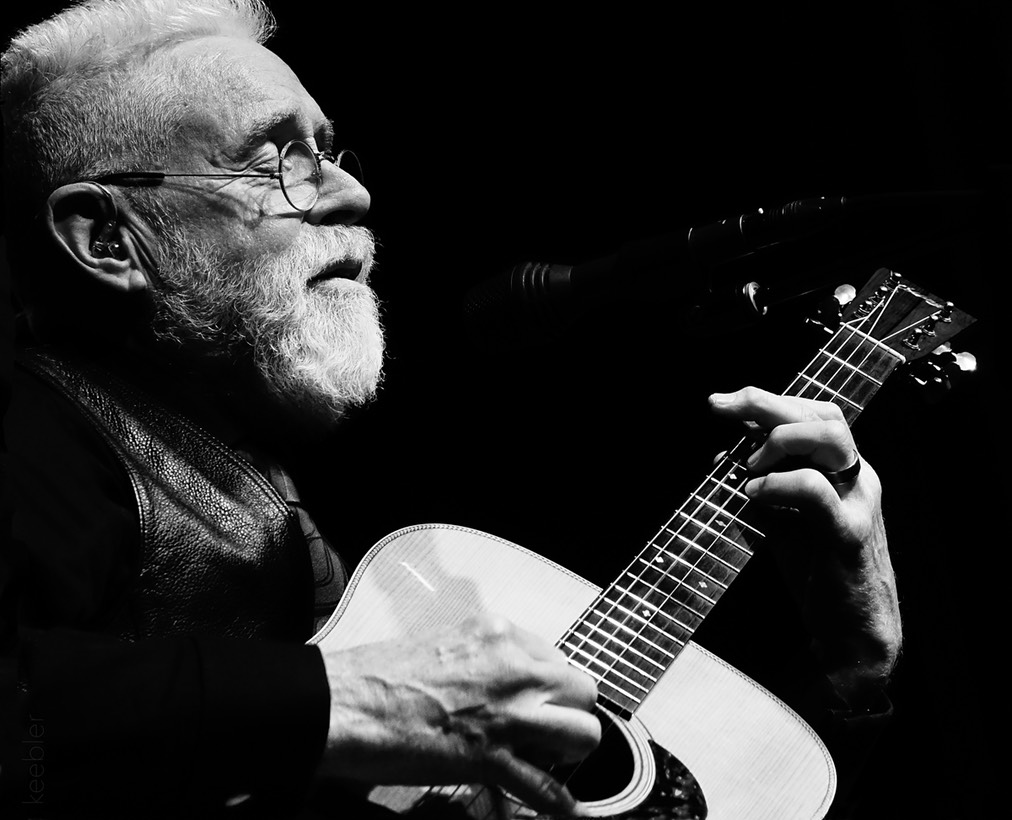
GW: You’re being kind of a ‘method actor’ then?
Cockburn: Yeah, I’m in the emotional state of when I wrote those songs in order to make them mean anything. It’s not by choice, either. It’s just what happens. It is how I feel I have to do it to make the songs real for people who are listening. Some of the songs are less pleasant to do that with than others. It was helpful to have that break.
GW: Looking ahead, could you share what your plans are for more tour dates beyond this next tour, which I know ends in early July?
Cockburn: My wife and family are probably going to want me to take some time and go somewhere, because she’s the one who needs the break. So I’m sure we’ll get away somewhere, and that might involve going back to Hawai'i. We’re looking at possibly adding some dates in the Southeastern U.S., in the November timeframe. Not confirmed yet, but that’s the general plan.
GW: Wrapping up then, Bruce, with one last philosophical question, coming back to the question of darkness and light. Obviously, with your faith, you have often expressed a fascination with the nature of existence, cosmic questions and starlight as a symbol. So time and again, you’ve shared your own spiritual outlook that seems certain but still allows room for the listener’s interpretation. Do you think we go to a good or a bad place when we die, or do you think we all become stars?
Cockburn: No, I don’t think we become stars. But I do think it’s very possible that we become [another form of] energy. And one point of view is that the energy we experience as living creatures dissipates and goes somewhere after our bodies die, right? Because, as we know, energy is not created or destroyed. The body goes to bits but the energy goes somewhere else. Whether it retains a consciousness or sense of its own identity is a different question altogether.
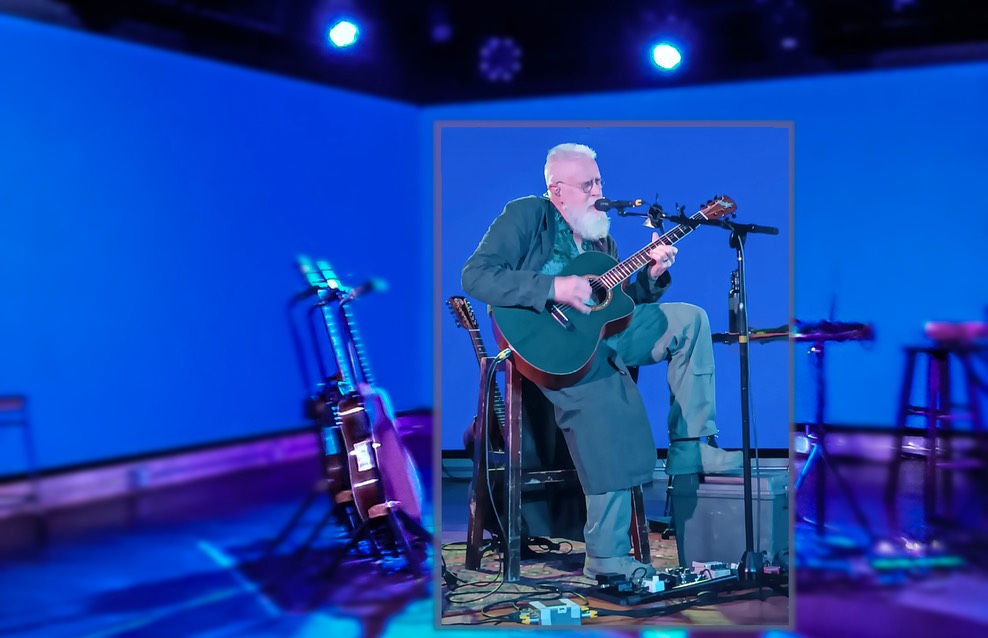
Some people think that it doesn’t, but I think it does. I do think there is darkness in the universe and you don’t have to look far to find it. I can buy into the Christian viewpoint, but I don’t think there are literally Pearly Gates or streets paved with gold. I think that’s a metaphor for something beautiful. And I kind of see it as involving a connection with the Divine and the ruling principle of the cosmos, which is a beautiful and loving presence.
I think when you look at a starry sky and you are moved emotionally by that, what’s moving you is your sense of connection with the bigness of everything. I think bodies get in the way of that, so if you get the body out of the way, then your relationship with that will become more direct, pure and accessible.
GW: Thanks, Bruce, for sharing some of your perspectives on what goes into your songwriting. Your imagery of stars is one of the things that stands out for me in your songs, and I appreciate hearing more of your thoughts about that.
Cockburn: There’s an incredible amount of beauty and energy out there. And who knows? We may all get swallowed up in a black hole!
PHOTOS 1 & 6 by Shannon Stevens
PHOTOS 2 - 5 by Daniel Keebler
March 27, 2024
Wilfrid Laurier University
Bruce Cockburn, Shelley Niro, Louise Penny and Mike Richter to receive honorary degrees at Laurier spring convocation laurier-honorary-doctorate
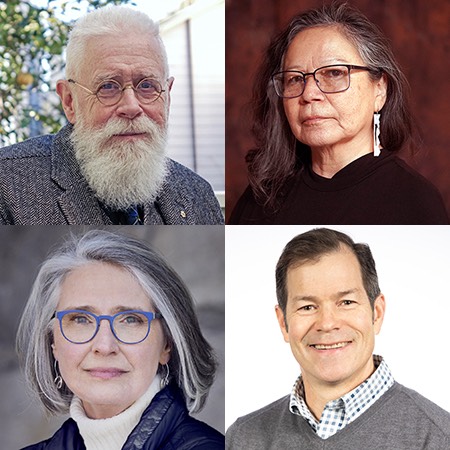
WATERLOO — Music icon Bruce Cockburn, celebrated Indigenous artist Shelley Niro, mystery author Louise Penny, and former NHL star Mike Richter will receive honorary degrees as part of Wilfrid Laurier University’s 2024 spring convocation ceremonies. Brantford campus ceremonies will be held at the Sanderson Centre for the Performing Arts on June 4. Waterloo campus ceremonies take place at Lazaridis Hall from June 10 to 14.
Bruce Cockburn
Doctor of Music | June 14, 9:30 a.m., Waterloo
Canadian music icon Bruce Cockburn has enjoyed an illustrious five-decade career shaped by politics, spirituality and musical diversity. His remarkable journey has seen him embrace folk, jazz, rock, and worldbeat styles of music while travelling to countries including Guatemala, Mali, Mozambique and Nepal to find musical inspiration. Cockburn’s many memorable songs include Wondering Where the Lions Are (1979), Lovers in a Dangerous Time (1984), and If a Tree Falls (1989), in addition to many others.
Deeply respected for his activism on issues from Indigenous rights and land mines to the environment and Third World debt, Cockburn has undertaken work with organizations including Oxfam, Amnesty International, Doctors Without Borders, and Friends of the Earth. An officer of the Order of Canada, the Ottawa-born artist has been honoured with 13 JUNO Awards, induction into the Canadian Music Hall of Fame and Canadian Songwriters Hall of Fame, as well as the Governor General’s Performing Arts Award.
Shelley Niro
Doctor of Letters | June 4, 10 a.m., Brantford
A multidisciplinary artist celebrated for her photography, painting, sculpting, beadwork and filmmaking, Shelley Niro is a member of Six Nations of the Grand River, Turtle Clan, Bay of Quinte Mohawk. Through her work, Niro challenges stereotypical images of Indigenous peoples. Among her recent projects is the 2023 film Café Daughter, which tells the story of a nine-year-old girl of Cree and Chinese ancestry struggling to find her place in a small Saskatchewan community.
Recently, works by Niro were featured as part of the exhibit “Shelley Niro: 500 Year Itch” at the Smithsonian National Museum of the American Indian in New York. Her education includes a diploma in the performing arts from Cambrian College (1972), an honours fine arts degree in painting and sculpture from the Ontario College of Art and Design (1990), and a master of fine arts from Western University (1997). Niro also studied film at the Banff Centre for Arts and Creativity.
Louise Penny
Doctor of Letters | June 13, 9:30 a.m., Waterloo
A number one New York Times bestselling author, Louise Penny is creator of the celebrated series of crime novels set in Quebec featuring Chief Inspector Armand Gamache. Since publishing the first book, Still Life, in 2005, Penny has won international accolades including nine Agatha Awards, named for Agatha Christie, as well as a Crime Writers’ Association Dagger Award. Her books have been translated into 31 languages and sold more than 10 million copies.
A member of the Order of Canada for contributions to Canadian culture, as well as the Order National du Quebec, Penny studied radio and television arts at Toronto Metropolitan University (then Ryerson Polytechnic Institute). She later joined the CBC as a radio host and journalist before writing her first novel. In addition to the Inspector Gamache series, Penny worked with former U.S. first lady and secretary of state Hillary Clinton to write the geopolitical thriller State of Terror (2021).
Mike Richter
Doctor of Laws | June 10, 9:30 a.m., Waterloo
Among the most celebrated goaltenders in NHL history, Mike Richter played 14 seasons in net with the New York Rangers. During that time, he recorded 301 wins, made appearances at three NHL All-Star Games, and helped the Rangers to a Stanley Cup victory in 1994, the team’s first championship in 54 years. In addition to his play with the Rangers, Richter was a key member of the U.S. Olympic hockey team, competing in Olympic Games in 1988, 1998 and 2002.
Following his retirement from the NHL in 2003, Richter studied ethics, politics and economics at Yale University, graduating in 2008. Today, he serves as president of Brightcore Energy, a U.S.-based business working to accelerate the transition to clean energy by helping clients reduce reliance on fossil fuels through a comprehensive approach to energy efficiency and clean energy resources.
Tickets are required for all Laurier convocation ceremonies. Members of the media are asked to RSVP to attend.
March 23, 2020
Mariposa Folk Festival Announces 2024 Lineup
by Eric Alper
The Mariposa Folk Festival returns July 5 to 7 to Tudhope Park in Orillia with a lineup that includes Old Crow Medicine Show, Bahamas, Band of Horses, Noah Cyrus, William Prince, Amigo The Devil, Donovan Woods, Dwayne Gretzky, Jesse Cook, Joseph, Maestro Fresh Wes, Modern Biology, The Secret Sisters, a special performance by Bruce Cockburn, and more.
The lineup was revealed today for the 2024 edition of the iconic music festival. The Mariposa Folk Festival was founded in Orillia, Ontario in 1961. Through the years, it has grown to become Canada’s most legendary musical gathering. Tickets for Mariposa are on sale via the festival website.
“The festival consistently sells out well ahead of time, and with such a well-crafted lineup, don’t wait much longer before purchasing your Mariposa 2024 tickets,” said Mariposa Folk Foundation President, Pam Carter. “We’re thrilled that families and groups of friends have chosen our event as their essential annual gathering. For 64 years, Mariposa has evolved while staying true to our roots for generations to come.”
In crafting his first Mariposa lineup, Artistic Director, Spencer Shewen, looked to present an engaging roster of talent that recognizes the Festival’s storied history while creating the opportunity to showcase new and exciting artists. “With the lineup we are presenting at Mariposa this year, our attendees are going to be able to see fan-favourites who they know and love as well as many great new and emerging acts that are starting to make waves on the world stage. I have no doubt that our guests are going to come to the Festival to see someone they’ve been listening to forever and, at the same time, leave the weekend with their new favourite band! I’ve always found that the most powerful thing about music festivals is the discovery piece – the opportunity to find something amazing that you didn’t know before attending, that could be the next big thing.”
The 2024 lineup will include: Old Crow Medicine Show, Bahamas, Band Of Horses, Noah Cyrus, William Prince, Bruce Cockburn, Amigo The Devil, Donovan Woods, Dwayne Gretzky, Jesse Cook, Joseph,Maestro Fresh Wes, Modern Biology, The Secret Sisters, Alex Nicol, Amanda Rheaume, B.A. Johnston, Balaklava Blues, Ben Caplan, Benjamin Doerksen, Billianne, Blue Moon Marquee, Bry Webb, Carleigh Aikins, Cassandra Lewis, Cat Clyde, CJ Wiley, Colin Linden, Crystal Shawanda, Doghouse Orchestra, Ellen Froese, Fellow Camper, Field Guide, The Fuddles, Good Lovelies, Gordie MacKeeman and His Rhythm Boys, Hussy Hicks, Irish Mythen, James Gray, Jeremie Albino, Jessica Charlie, Jiggity James, Jon Muq, Ken Whiteley, Kim Churchill, Lawrence Maxwell, Leeroy Stagger, Mattmac, Mia Kelly, Nancy Kopman, Okkervil River, Old Man Luedecke, Onion Honey, The Paddling Puppeteers, Rick Fines, Rose Cousins, Royal Castles, Sarah Shook & The Disarmers, Shad, Shaina Hayes, Shawnee Kish, Shebad, Splash’N Boots, Union Duke, The Vaudevillian, Willows, Wyatt C Louis, Young Maestro, and Special Guest Tom Power.
Shewen is particularly pleased with the number of exceptional songwriters in the lineup: “With such gifted composers and lyricists as Donovan Woods, Cat Clyde, CJ Wiley, and many others, I look forward to magical Mariposa moments in workshops, on side stages, and on the Lightfoot Main Stage.”
The three-day Mariposa Folk Festival features 11 stages of top folk-roots music, along with presentations of story, dance, and craft. All ticket categories are on sale. Children 12 & under are admitted free. The festival has special pricing for youth and young adults. Onsite camping is available.
February 28, 2024
Billboard
TikTok Thinks Beyoncé’s ‘Texas Hold ‘Em’ Sounds Like This Classic Canadian Children’s Show Theme Song
And the singer of that tune, Bruce Cockburn, has no problem with it.
by Gil Kaufman
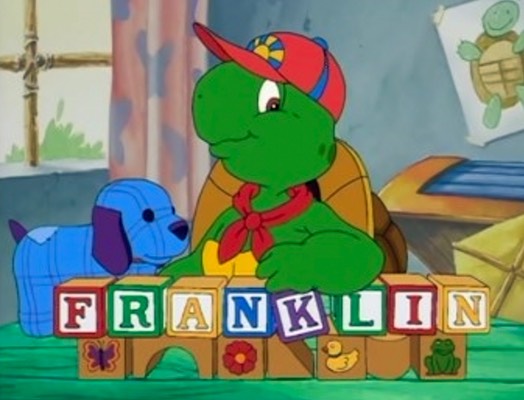
Beyoncé is already making history with her swerve into the country lane. But after scoring a surprise No. 1 hit with “Texas Hold ‘Em,” some of Queen Bey’s Canadian fans think her new two-step has a familiar ring to it.
A week after TikTok videos pointed out that the tune’s bouncy finger-picked intro bears a striking resemblance to the theme song from the late 1990s/early 2000s children’s cartoon Franklin, the musician behind that show’s iconic opening track, “Hey, It’s Franklin,” says he’s just fine with the comparisons.
According to TMZ, veteran Canadian rocker Bruce Cockburn, 78 — best known for his 1984 hit “If I Had a Rocket Launcher” — told the outlet that he is honored by the many side-by-side videos. “I think Beyoncé’s ‘Texas Hold ‘Em’ is a good record. Unfortunately, I can’t claim to have any part in writing it,” he said.
“The rhythmic feel is similar to my theme song for the Franklin TV series, but to my ears, that’s where the similarity stops. ‘Texas Hold ‘Em’ is her song, and I wish her success with it!” Cockburn added.
It appears the resemblance was first pointed out by TikTok user Ashleigh Aedan on Feb. 18, when she played a bit of the Bey song and captioned her video, “Now go listen to the Franklin theme song and tell me these are the same”; that clip has since racked up more than 3.5 million views. The post began making news in Canada soon after, with a radio DJ doing a mash-up that boosted the notion that the songs share a similar git-up.
A music expert told CBC News that the comparisons make sense since both use fingerstyle plucking, instead of strumming, with Beyoncé’s opening with a banjo played in the Clawhammer style. Musicologist Claire McLeish said the Franklin theme opens with a style called Travis picking, with a “strong Clawhammer influence.” McLeish also pointed out that both are played in the key of D, with the instruments tuned in a similar style, which is what McLeish said people are picking up on.
And while they sound similar, McLeish said “they don’t sound alike in a way that would cause any legal problems” because you cannot copyright an “idea,” and the Travis picking style is a common idea used in country and folk music all the time. In fact, McLeish compiled a playlist of songs in a similar style, including ones by Johnny Cash, Led Zeppelin and Cockburn, noting that since Beyoncé isn’t using the same melody or lyrics that are close to the Franklin theme it’s probably safe from any legal issues.
Last week, Bey became the first Black woman to top the Billboard Hot Country Songs chart, followed by the track topping the Billboard Hot 100, giving the singer her ninth leader on the list.
February 25,
2024
The Bruce Vortex
by Frances Figart
There are times in our lives when something new approaches, and we somehow recognize it is for us. A form appears and intuition tells us to move toward it, though we may not fully understand why until later.
In February of 1985, I drove from Kansas, where I was in college, to central Kentucky to visit my parents. As soon as I got in range of WKQQ, the radio station I grew up on, I set the stereo to 98.1 FM. As all the familiar sights of the Bluegrass came into view—tobacco barns, fields of thoroughbreds, dry-stone fences—an unfamiliar song wafted out onto the airwaves.
Its opening bars conjured up the rich brown, green, pink, and orange hues of a tropical jungle. As the melody took shape, it elicited both excitement and sadness. Then a sensitive, vulnerable voice I’d never heard before started singing about helicopters and murdered kids and God as drums kicked in to emphasize a refrain I couldn’t believe I was hearing: “If I had a rocket launcher, I’d make somebody pay!”
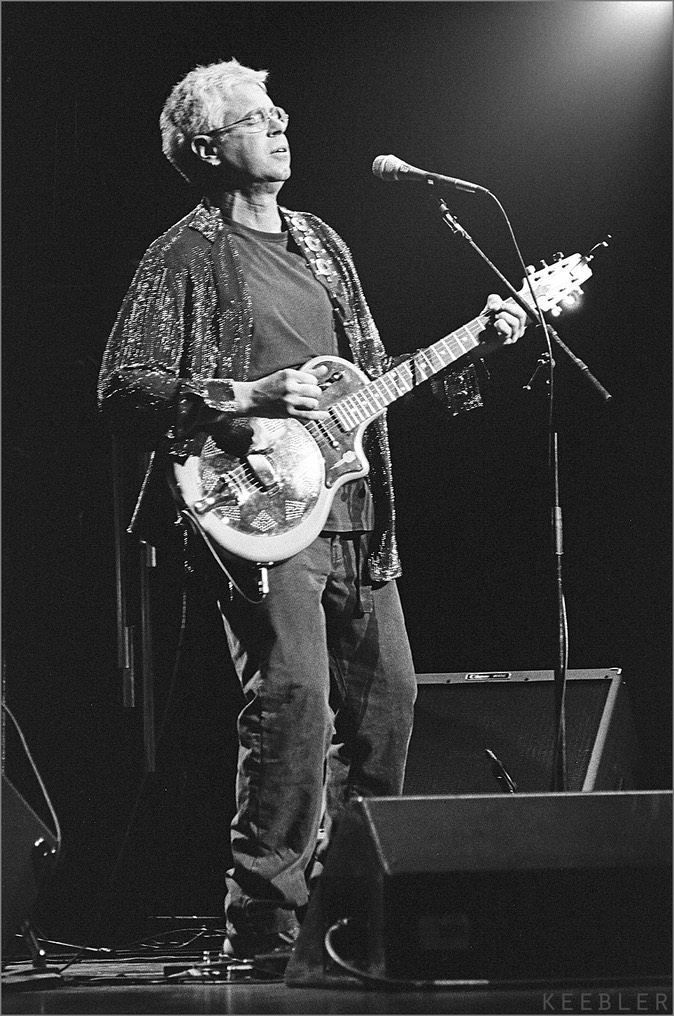
Wow. I pulled the car over along the side of the state road, put it in park, and closed my eyes. I thought about another, older song that began with those same four words expressing desire, hope, a wish: “If I had a…” Pete Seeger had sung them in “If I Had a Hammer,” and I’d listened countless times to Peter Paul and Mary’s rendition as a child. That song—which calls for justice, freedom, and “love between my brothers and my sisters all over this land”—went on to become a protest anthem for the civil rights movement.
But this? This was something other.
This singer was so upset by guarded borders, hate, generals, torture, and “things too sickening to relate” that he was ready to take up arms against the perpetrators and retaliate! Yet this plaintive, intelligent voice could only belong to someone who was, under normal circumstances, a rational, level-headed guy. A nonviolent person. Someone I would be friends with. Someone like me.
Who was he singing about? Where was this problem? He mentioned an exotic sounding place I didn’t recognize where “one hundred thousand wait to fall down from starvation—or some ‘less humane’ fate.” Then I heard a place name I did know: Guatemala! One of my English Lit professors had been spending summer breaks writing about conflicts in Latin America, dividing his time between the Contras in the Nicaraguan revolution and a group of people helping some displaced Guatemalan farmers in Mexico who were being attacked by their own government—with financial backing from ours in the US. He would come back to the university every fall charged up about the issues, which I didn’t begin to understand. This guy must be talking about that same situation.
It hit me that what was coming through my JBLs was a far cry from Tom Petty wailing, “You don’t have to live like a refugee.” This strange new troubadour was invoking despair and outrage in me for a situation he had actually witnessed involving real refugees! Then I heard that peaceable voice invoke the guttural punch of a crusty old jazz singer. Did he really just say that if he had a rocket launcher “some son of a bitch would die”?
In five minutes, my whole world changed. I was reminded of the protagonist Beth Harmon in the book I was reading by Walter Tevis: The Queen’s Gambit, which was set in Kentucky, not far from where I was now parked. When orphaned Beth first saw a chess board, she knew this strange new landscape was “for her” and she couldn’t get it out of her mind. I had a feeling that I’d only seen the tip of the iceberg, that this song was just one small part of what had to be a much larger body of work. If this one piece of the jigsaw could do what it just did to me, then there was a lot more to learn from this artist.
I could discern this songwriter was on literary par with the poetess Joni Mitchell, through whose musical eyes I had been synthesizing the realm of relationships since I was eleven. Now I was 21. I could also tell this guy had an astute sensibility beyond the typical Top 40 fare and suspected this song had only made it onto my hometown rock-n-roll radio station because of the shock factor of its last line. And now listeners who might have no clue about the political situation referenced would perk up their ears and wonder, like I did, what the hell was going on—all because of this bad ass singer . . . what was his name?
“That was the Canadian artist Bruce Cockburn,” said the DJ, pronouncing the “ck” in “cock” like he wasn’t supposed to, which I would soon find out because I was now on my way to Bear’s Wax Records to see if I could find the album. Stealing Fire was there alright, and the enthusiastic store owner had a world of information for me, including how to pronounce Bruce’s last name, and the fact that the album had been released in 1984, “Rocket Launcher” got pegged as a single, and had just now broken through to the US Billboard charts. He considered Bruce the Canadian Bob Dylan and told me he’d been recording for more than a decade already.
~~~
Within an hour’s time, I had entered an unexpected vortex that has now lasted 39 years. Bruce joined my personal Top Five favorite singer–songwriters at that time—the aforementioned Joni Mitchell, Laura Nyro, Pete Townsend, Neil Young, and Todd Rundgren—making it the Top Six. Over the years, the lineup has shifted, but no matter who I’ve been listening to, Bruce has continually held the pinnacle ranking. In that age-old imagined scenario of going to a desert island and having to choose only one artist’s work to take with you, mine would always be his.
Stealing Fire was where I entered the whirlpool, but I rapidly went back in time to acquire and listen to all the albums Bruce had crafted up until that point. Then, I followed along with him into the future, swiftly purchasing each new offering as it became available and turning on all who would listen. Thirty years ago, in February of 1994, Daniel Keebler started the print version of Gavin’s Woodpile, and I began to receive it a short time thereafter. When Bruce wasn’t touring in the areas where I was living, I traveled to see him whenever possible. For years his songs were on my mix tapes; when CDs became popular in the late the ’80s, I began to duplicate the entire discography that I already had on vinyl. During the times of greatest emotion, whether it be deep sadness or expansive joy, only Bruce’s music and lyrics could match the complexity, reflect what I perceived as the dignity of my feelings.
Bruce was coming from a Christian viewpoint, yet he had an inclusive world view that treated all cultures and religious beliefs with equal respect. This offered me a huge and needed comfort zone. Being raised Southern Baptist, but never having had my parents’ religious convictions, I rejected God in my late teens because I only had one framework for viewing the concept—and it just wasn’t working for me. I couldn’t accept that a creator had a gender and would choose only one group of people to participate in eternity. I considered myself an atheist when I found Bruce in 1985, yet I still identified closely with most of the viewpoints expressed in his songs because foundationally my language, culture, and social milieu were based in Christianity. My alignment with him came not from religion, but from the fact that, like me, he (or at least his persona in his songs) struggled with his faith just as he struggled with the atrocities humans perpetrated on other humans and on the planet. His was not the haughty fundamentalist Christianity of someone who pretended to have all the answers and doled them out blindly without question or thought. He grappled with the ramifications of all the horrors and all the ecstasies, whipping into the storm.
In the early ’90s I was so inspired by seeing him play in Cincinnati that I came out of the concert, “A Dream Like Mine” ringing in my mind and heart, and said to my companions, “I’m going to go to another country and save an endangered species.” What I ended up doing with that energy was looking in my own backyard and finding someone who needed help closer to home. I started a nonprofit to give low-income women in Eastern Kentucky a better chance at economic stability.
Later that decade I would send Bruce a note to ask if I might talk to him at a show in Chattanooga on The Charity of Night tour. I wanted to see if he might entertain the idea of doing a fundraiser for my nonprofit. He sent me a postcard from a New York hotel and told me to come backstage after the show. I drove from Lexington to Chattanooga, the concert was fantastic, and after the lights came on, I went up to someone breaking down the equipment and said, “Bruce told me to come and see him after the show.” I was sure I would be cursorily dismissed. “What’s your name?” asked the roadie. “Frances.” “Oh yeah, he’s expecting you.”
I was taken down a tiny hallway that led to an even more diminutive dressing room where I spent an unforgettable half an hour with Bruce. We talked about everything from hands and feet to rock climbing and horseback riding to languages, writing, and poetry, to family and relationships to the books we were reading. I felt wholly inadequate to express myself—not because of any distance Bruce created; he was quite relaxed, encouraging, and friendly. I was simply overcome with the cumulative admiration I had been nurturing for so many years that revolved around this person and all that he had been willing to share, that I was rendered woefully inarticulate.
Recently, I was delighted to find that M. D. Dunn gave this phenomenon a name on page 6 of his new tribute to Bruce, You Get Bigger as You Go. He calls it “The Bruce Effect” and laments in reference to an interview he conducted with Bruce, “I am embarrassed by how nervous I was: voice stammering, quavering.” He goes on to describe exactly what happened to me: “There can be moments in a conversation with Bruce when one’s mind goes to mush, the circuits overload, and everything shuts down. It’s nothing that Cockburn does; and for people with an appreciation of his music, it has nothing to do with fame or celebrity. Anyone who understands the significance of the man’s music and activism cannot help but be occasionally overwhelmed.”
Considering my own
bumbling attempts at communication with Bruce that night in Chattanooga, I am
glad to know others have had similar experiences. Bruce ultimately told me I
could try to get Bernie Finkelstein to let him do a fundraising gig, but it
would be a hard sell. We never did it. But I still consider that meeting to be
one of the most important events of my life on earth.
~~~
As anyone who follows Bruce understands, there is no way to pick even a set of favorite songs; it just doesn’t work like that. We all love the entire body of work and how it constantly unfolds as a whole. Yet I can point to a few personal highlights.
Both “Coldest Night of the Year” and “Last Night of the World” share details of a very specific moment in time that yet reflects our own lives back to us in the generalities. “I drove all the people home; I was the one with the car”—who can’t relate to that? “I've seen the flame of hope among the hopeless, and that was truly the biggest heartbreak of all.” This line circles me back to the refugees who inspired Bruce to write the song that helped me and many others in the US to find him. These nostalgic yet hopeful songs about what might have been or could yet be help us to feel more connected to the people on the periphery of our lives who always made us wonder about the quantum possibilities.
If it’s love songs you seek, they don’t come any better than “Don’t Have to Tell You Why,” “See How I Miss You,” “All the Ways I Want You,” “Bone in My Ear,” “Live on My Mind,” “The Coming Rains,” “Wait No More,” and “See You Tomorrow.” Bruce has an uncanny talent for infusing songs about romantic love, sexual desire, and domestic bliss with the more expansive sensual connection to the divine that is our true love story.
Tunes like “Creation Dream,” “How I Spent My Fall Vacation,” “Understanding Nothing,” “Open,” “Put it in Your Heart,” “Tried and Tested” and “Burden of the Angel Beast” act as fuel providing the energy, endurance, and determination necessary to persevere in the quest for greater creativity and deeper connection. I have come to think of “Get Up Jonah” as one of the best spiritual poems ever written—and when you add the musical composition, the whole concoction blasts out into the stratosphere, taking the listener with it.
For years I have used “Love Loves You Too” as a closing exercise in Myers Briggs Type Indicator trainings to help various groups understand and appreciate personality differences and our multitudinous human roles. “Joy Will Find a Way,” “Hoop Dancer,” “Going Up Against Chaos,” “Strange Waters,” “Use Me While You Can” and “To Fit in My Heart” have each contributed profoundly to my ever-widening spiritual perspective—over and over again.
“Child of the Wind,” an epic piece which ironically ended a rare dry spell in Bruce’s creativity and is one of his finest compositions ever, taught me to step outside the view of God I didn’t like and see the much bigger picture:
Little round planet
In a big universe
Sometimes it looks blessed
Sometimes it looks cursed
Depends on what you look at obviously
But even more it depends on the way that you see
Works like “Call it Democracy,” “If a Tree Falls,” “Stolen Land,” and “The Trouble with Normal” continually vindicate my views of world (and especially American) policy. As Bruce posits in his dazzling memoir, Rumours of Glory, politics actually demand art. “If an artist’s job is to distill the human experience into something that can be shared, then the political, as much a part of that experience as God or sex or alienation, deserve[s] to be seen as raw material. The arts contribute significantly to social movements and cultural cohesion.”
Dunn wisely points out that we “grow into the music we love. Sometimes we are not ready for it, but the music waits. It works quiet magic in the background of our lives, each note leading us to the next discovery.” This was the case for me with Joni Mitchell as a child morphing into a young woman, and the same has been true for me with Bruce as an adult on a circuitous path of learning that is finally getting a little less curvy.
When my mother
died in 2012, I’d been her caregiver for over a year. She transitioned just
after midnight. A close friend and I stayed up the rest of that night cleaning
and rearranging the house. Bruce’s was of course the only music that was possible
to hear during this stunning, elongated moment of dire grief. I had Humans on and “The Rose Above the Sky” came around—I had heard it hundreds of times
and never understood what it meant until that instant:
Something jeweled slips away
'Round the next bend with a splash
Laughing at the hands I hold out
Only air within their grasp
All you can do is praise the razor
For the fineness of the slash
~~~
Since I first encountered the music and got sucked into “The Bruce Vortex,” a week hasn’t gone by that I haven’t listened to him. Some of my deepest friendships and even a few of my professional relationships revolve around a connection to Bruce’s art.
I have seen Bruce loping onto the stage in his humble yet confident way and felt I could detect a kind of burden being carried, a yoke that tethers him to his role as a performer of these truths for which he has been such a powerful and translucent conduit. Sometimes I have sensed that, more than anything else, he’s bound and driven by an unshakable brand of spiritual stewardship.
Largely because of Bruce’s influence, I transitioned from nonbeliever to untroubled agnostic—the stance of “I don’t know all the answers about whether or not there is a God and that’s okay—I’m not designed to know.” But over time, I came to see in a different way. I now understand that nothing’s too big to fit in my heart. God doesn’t look the way I was raised to believe it would. I understand spirit differently than I ever thought possible. Through the combination of several spiritual practices and listening to Bruce, I can say, like him, that “in my soul, I’m on a roll.”
According to some wisdom traditions, when a student is ready, their guru shows up. They get an overwhelming feeling of love and adoration from being in the presence of the sadhu or holy one. But it is not the guru that is the object of adulation or worship. It is the divine manifesting through another human that causes the feeling of overwhelming joy. In his seminal bible of the counterculture, Be Here Now, Ram Dass explains that spiritual guidance appears when we need it and can be “in the form of a teacher or a lover or an enemy or a pet or a rock or a chemical or a book or a feeling of great despair or a physical illness or the eyes of a person you pass on the street.” Some people are put off by the notion that a human being can radiate the power of the divine. But I understand the concept of the guru through the alchemic effect that Bruce’s work has had on my life.
Last summer, I was privileged to be able to see Bruce play in Atlanta. Everyone I encountered there was smiling, and many were crying from the joy of being in his presence again. I had brief but deep conversations with several people I had never met, exchanging embraces when we parted ways. Like Zen meditation or shamanic ceremony, the path of Bruce Cockburn’s music is not for everyone. But for those who take up the mantle, the benefits are immense.
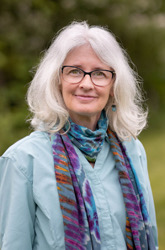
In Rumours of Glory, Bruce explains how he “wasn’t sure the listening public would accept ‘Rocket Launcher.’ I was afraid that if it did, I would be promoting a violent response to the violence the song deplores.” I’m so thankful today that, as he says, “common sense won out,” and Bruce decided it was worth the risk to tell the story of what was going on beside the Río Lacantún.
Frances Figart (rhymes with “tiger”) is a writer, editor, and creative director living in East Tennessee. Today is her 60th birthday. She has tickets to see Bruce on May 2 in Austin. You can reach her at ffigart@gmail.com.
February 16, 2024
Cashbox Canada
You Get Bigger as You Go – A Personal Interview with Author M.D. Dunn
by Lisa Hartt
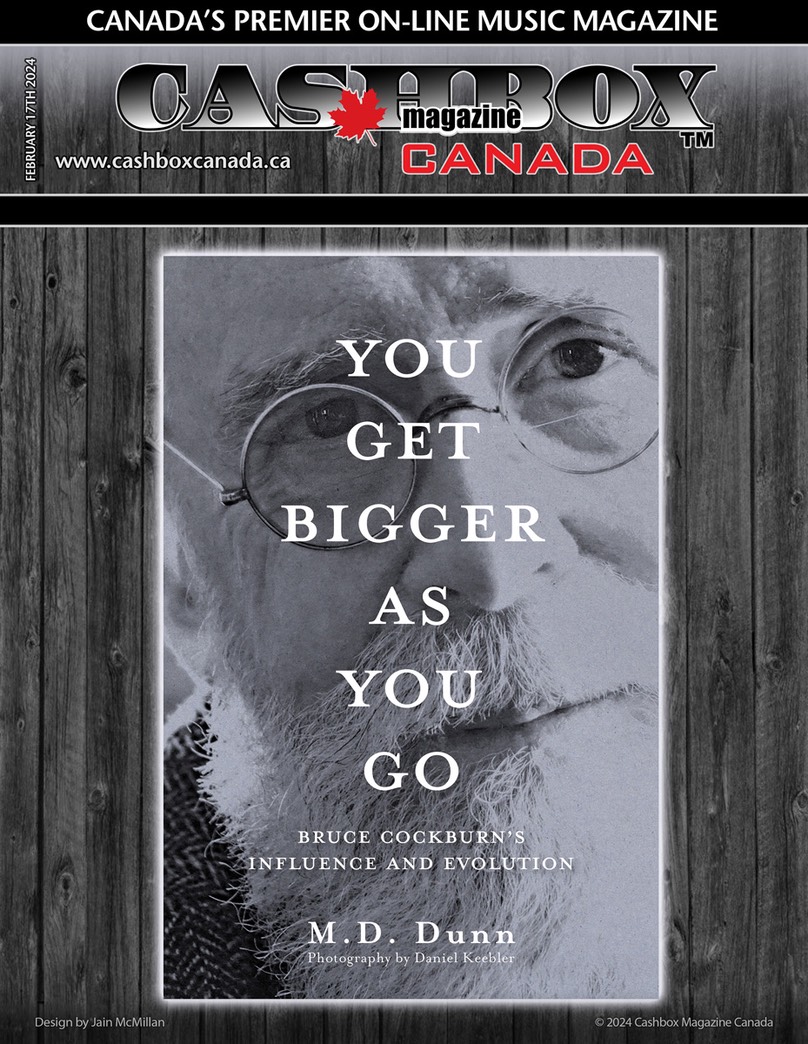
I have just finished reading “You Get Bigger as you Go”, Bruce Cockburn’s Influence and Evolution by author M.D. Dunn.
What a wonderful rabbit hole to fall into! I As the reader, I was immersed for weeks in Bruce’s music, playing the tracks from all the albums that Dunn delves into, as I read the book. I followed the timeline along with Mark Dunn’s research and exploration of all Cockburn’s albums. This book explores the profound influence and remarkable evolution of Cockburn’s music. A renowned Canadian singer songwriter and guitarist, Cockburn has entertained and educated listeners for over five decades.
Speaking with Mark recently about the book, we discussed the fact that Bruce is like a war correspondent, a journalist observing through his lens of music the times we live in, complimented by the poetry of his complex guitar phrasing. Cockburn digs deep into the pathos of the song.
Mark reflected that: “Bruce is almost always the narrator in these songs, and they are not always about him, but they are always a reflection of his point of view.”
Author M.D. Dunn takes us on an obsessive and humorous quest to track Cockburn’s cultural footprint and reflects on his own early introduction to Bruce’s music and how writing the book became a 7-year quest of immersing himself in the complete catalogue and as Mark says, “There is not a bad album in the catalogue”. The book is interspersed with interviews with Bruce, and meetings and interviews with many of the key players, like the legendary Bernie Finkelstein, close friends, and colleagues of Bruce’s, to get a clear picture of his generosity of spirit, his spiritual journey, his activism, and his love of nature. Black and white photographs from the archivist Daniel Keebler help to illustrate the different life passages of Bruce at home, in the studio, and on the road.
We talked at length about the passage in the book where Mark describes that we all come to Bruce’s music at different times in our lives. For him it was a cassette tape that was unlabeled with no liner notes in a thrift shop when he was fourteen “Joy Will Find a Way” which affected him so profoundly. For me it was “Goin’ To the Country” released in 1970. And so, wherever you come to Cockburn’s music, that is THE album for them. As a Montrealer, I believed we always had the ‘cool’ music first in Canada. Bruce always included French Lyrics on his albums and in his songs, so he was played extensively in Montreal on CHOM FM, the station of global inclusivity and diversity at the time as well as CJFM, the softer rock station of the City.
During our lively conversation, the author and I delved into the place of Bruce’s activism and how much great courage and self-discipline it takes to walk that path and be committed. How in one passage in the book, Bruce wrestles with the thought that the last line of “If I had a Rocket Launcher”, could be seen as a call to violence. He had been in such rage and grief writing that song after witnessing the refugee camps that had been decimated, killing women and children in South America. Cockburn worried that the rage was palpable in that song. Bruce says in the book: “It is still painful to sing that song. I put myself where the song is. It is painful. I don’t like singing it.” The book really delves into the trajectory and platform of his activism and there are interviews with people who accompanied him to Guatemala and Nicaragua that illuminate his integrity and shyness around acclaim for his participation. What Cockburn writes is thoughtful and researched and chosen out of a deep expression of belief in the group he is representing and not for opportunistic reasons.
Following the journey of Bruce Cockburn’s spirituality is also a revelation in the book and now makes so much more sense to me considering the descriptions of the albums created the maturity developmental period in this book’s timeline. The music gives us clues as where Cockburn is on his faith journey. It is wonderful that M.D. Dunn extrapolates the world news as we explore Bruce’s discography. It makes so much sense to me through reading this book, how mature he was as a thinker and an artist for change.
Mark and I spoke about the journeys we must all be on and that our choice of music is our companion, our guide, our Gandalf. This book is like that, it opens every moment for discussion and very beautifully speaks to the poetry of Cockburn’s lyrics, as we search our own journey on the timeline for similarities.
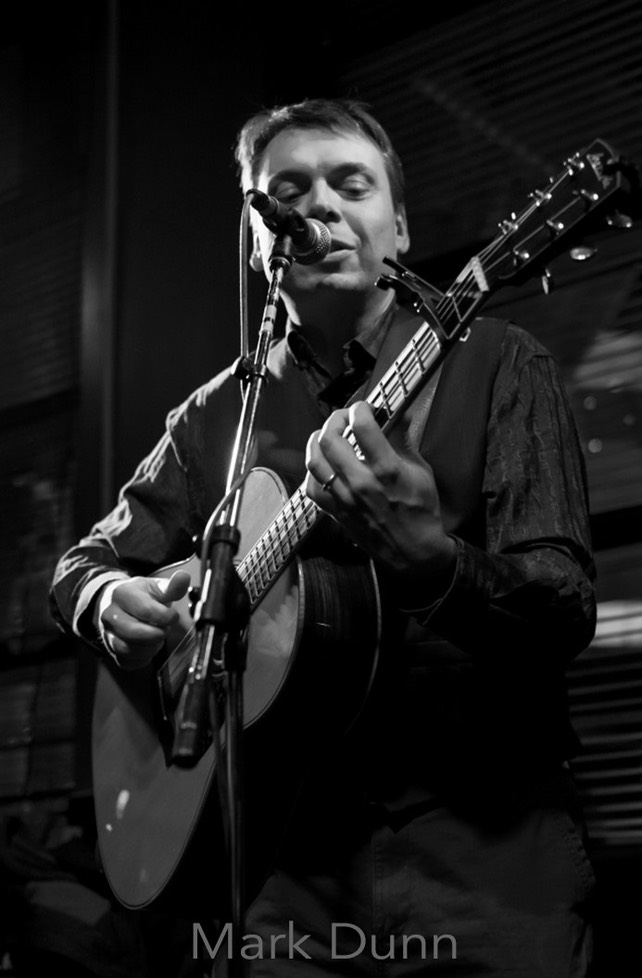
I especially like how the author timelines Cockburn’s quest for spirituality. We the reader have the opportunity through descriptions of different albums and interviews to immerse ourselves in Cockburn’s journey. Asked in 2021 his concept of God Bruce says “It’s tricky, I got into a sense of God, the cosmic-ness of God that I think about most often. it’s a little like pantheism. God is in everything. Nothing exists without god’s permission, would be a Christian way of saying it. Having set the universe in motion. It doesn’t mean that “he takes an interest in every single detail. If you can imagine a person. While there is this cosmic thing, there is also a presence in the heart (brings both hands to his chest) that’s inescapable for me. And I want to know more about it. I never feel I know enough about it, that I have a clear enough channel to it. I like the Kabbalist notion of “Ein Sof” which is “The Boundless. In other words, you can say anything you want about God, but you’re never going to cover it. And so, all the images in a way are suitable, but limited. And you must be aware of the limitations of that imagery.”
Dunn writes: Cockburn’s spirituality is often described as ‘bordering on the mystical’. He has read widely and with an open mind, drawing from Christian studies, the Kabbalah, the occult, and Buddhism, among other traditions, to form a faith system that seems fluid and ever evolving but still Christian. Suffice it to say that Cockburn believes in a personal savior that transcends all physical limitation. It’s The Boundless, as he says, Boundless without end.
In conclusion: I highly recommend this book for anyone who loves and lives for the back stories in Bruce Cockburn’s music, and for those who embrace our Canadian perspective. The book is so well written and researched that it was very hard not quote or wish to discourse on every topic. There was so much meaning and integrity of language throughout the whole tome.
M.D. Dunn (you can call him Mark) has written and performed music for more than thirty years and released nine albums as of 2023. A teacher and a poet, Dunn’s writing has been published in the Globe and Mail, the Literary Review of Canada. The Rumpus, Public works Magazine, Contemporary verse 2, and many other outlets. He lives in Sault Ste. Marie, Ontario, Canada, where he teaches writing at Sault College. Find him online at www.mddunn.com.
As the author says: “The book is not perfect, and there is much more work to be done with Bruce Cockburn’s music and its cultural presence. I hope that this small offering might continue and advance the discussion.”
Fermata Press is a micro press for quirky books about music, who are dedicated to giving readers insightful, engaging, and strange books. Contact at FermataPress.com.
February 3, 2024
American Songwriter
The Insurgent Anger Behind “If I Had a Rocket Launcher” by Bruce Cockburn
by Bryan Reesman
Even peace-loving types can get fed up. And that is the anger and angst that Canadian singer-songwriter Bruce Cockburn tapped into for his folk-rock classic “If I Had a Rocket Launcher.”
Cockburn, whose 38th studio album O Sun O Moon came out in May 2023, has always been known for his artistic passion and social and political consciousness. His music has spanned a wide range of influences as well. On his 1984 album Stealing Fire he recorded many intense political songs, including “Lovers in a Dangerous Time,” and “Nicaragua.” The former song had a lyric (got to kick at the darkness till it bleeds daylight) that U2 later referenced in the song “God Part II.” The Irish band reportedly considered covering “If I Had a Rocket Launcher,” but never did.
Intense Inspiration
When it came out, “If I Had a Rocket Launcher” actually received a good amount of radio airplay and was shown on MTV. The incendiary song was inspired by Cockburn’s first trip to Central America that was coordinated through Oxfam in 1983. After visiting a Guatemalan refugee camp in southern Mexico that had been attacked by Guatemalan army helicopters—who untruthfully claimed it was a haven for guerrillas fighting the country’s American-backed dictatorship—he was inspired to write the song. It chronicled what he had seen in Central America and expressed the anger and outrage he felt or what he had experienced and witnessed.
Here comes the helicopter—second time today
Everybody scatters and hopes it goes away
How many kids they’ve murdered only God can say
If I had a rocket launcher … I’d make somebody pay”
While like their predecessors, the folk singer/songwriters of the ’80s certainly espoused peaceful solutions to political and military problems. But Coburn takes a darker turn here and as he does, each of the song’s four choruses grows more intense.
If I had a rocket launcher …
(Chorus No. 1): I’d make somebody pay.
(Chorus No. 2): I would retaliate.
(Chorus No. 3): I would not hesitate.
(Chorus No. 4): Some son of a bitch would die.
In the mid-1980s, some Canadian radio stations were reportedly uncomfortable playing that last chorus so the song was faded out in an edited version. The single was not a big hit at the time, having reached No. 49 on the Canadian charts and No. 88 on the Billboard Hot 100. It is one of only two Cockburn songs to ever chart in America.
But don’t let the chart numbers fool you. This song was actually a rallying call to metaphorical arms and its impact and popularity grew over time. (“Lovers in a Dangerous Time” from the album has also been influential and covered by Frazey Ford, Oysterband, Dan Fogelberg, and Barenaked Ladies, the latter scoring their first Top 20 hit in Canada with it in 1991.)
Mixed Messages
About “If I Had a Rocket Launcher,” Cockburn told the Vancouver Sun in 2017, “A lot of people relate to it currently, in terms of Iraq or Afghanistan or Syria, any number of places. Unfortunately, we don’t seem to be running out of war and pain.”
But audience reactions can vary. Cockburn recalled that at one of his own concerts he was scared by witnessing 2,000 Christians at a British music festival in the 1980s enthusiastically singing to the last chorus. “There’s nothing joyful or celebratory about it,” he told the Sun. “It’s truthful, but that’s not a pleasant truth to me. I don’t like reliving it.”
Conversely, when he played Santiago, Chile to support banned artists during the military dictatorship of Augusto Pinochet, a Chilean singer translated each line Cockburn sang into Spanish. “When we got to the end, the audience was on its feet,” Cockburn recalled. “That was also quite chilling. These people had a different perspective on it.”
Twist Ending
In August 2009, Cockburn visited his brother Capt. John Cockburn, a doctor who was serving with the Canadian Forces at Kandahar Airfield in Afghanistan. He performed this song for the troops to great applause. On a lark, the commander of Task Force Kandahar, Gen. Jonathan Vance, presented the singer/songwriter with a rocket launcher.
“I was kind of hoping he would let me keep it,” Cockburn quipped to the CBC. “Can you see Canada Customs? I don’t think so.”
February 3, 2024
James Toth Presents… ‘Imaginational Anthem Vol. XIII – Songs of Bruce Cockburn’
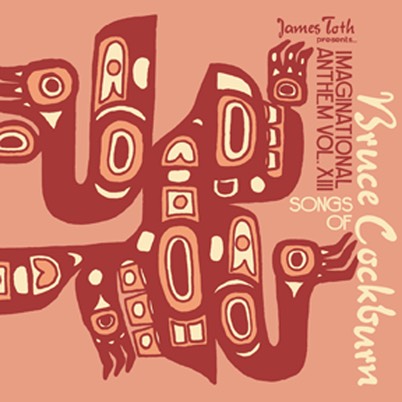
Bruce Cockburn is one of the most celebrated Canadian artists of all time. Unlike fellow Canadians Leonard Cohen, Joni Mitchell or Neil Young, Cockburn has not been fully embraced by a younger generation of indie musicians and younger fans. Tompkins Square recruited well-respected indie artist James Toth, known for his work with Wooden Wand, to curate the 13th volume of its guitar series, Imaginational Anthem, out April 5, 2024. Although there is a focus on Bruce as a guitarist, there are also vocal tracks on the album. Indie stalwarts Bill Callahan, Matt Valentine, Luke Schneider and Jerry David DeCicca all step up and pay tribute to this musical hero, proving that Cockburn is not only influential, but also the keeper of a deep catalog of songs ripe for discovery by a younger generation. PURCHASE HERE.
Foxglove – Eli Winter
40 Years In The Wilderness – Jerry David DeCicca (featuring Bill Callahan)
Up On The Hillside – Matthew “Doc” Dunn
Fall – Powers Rolin Duo
Pacing The Cage – Lou Turner
Waiting For A Miracle – Wet Tuna
One Day I Walk – Armory Schafer
You Don’t Have To Play The Horses – Jody Nelson
All The Diamonds – Kyle Hamlett Duo (featuring Luke Schneider)
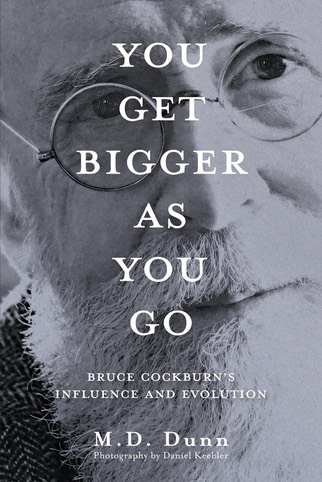
January 17, 2024
SooToday.com
Meet Bruce Cockburn (virtually) at the Sault Museum
Canadian music giant's life captured in a new book by local author Mark Dunn; free event on Feb. 11 will include a reading, door prizes and Cockburn answering questions
Canadian music icon Bruce Cockburn will be in Sault Ste. Marie virtually next month promoting a new book that celebrates his long and remarkable career.
You Get Bigger as You Go: Bruce Cockburn's Influence and Evolution was released in December and has topped Amazon bestseller lists in multiple categories, reaching No. 1 in folk and country biographies.
The Sault Ste. Marie Museum will host a launch for the book by local author and musician Mark Dunn. There will be door prizes, book sales, a reading from the book, and music. Cockburn will take questions. The event is free, but space is limited. Reserve a spot through the museum's website, or drop in to the gift shop.
The book is available for purchase in SSM at The Rad Zone and the SSM Museum Gift Shop, through bookstores, and online through Amazon, Chapters, and elsewhere.
Book launch: You Get Bigger as You Go: Bruce Cockburn's Influence and Evolution
Sunday, Feb. 11
2:30-4:30 p.m.
Admission is free, but space is limited
Reserved seating
January 17, 2024
Sault Ste. Marie Museum
You Get Bigger As You Go
Bruce Cockburn Book Event
The event will be held on February 11, 2024, from 2:30pm - 4pm in Sault Ste. Marie, Ontario
You Get Bigger as You Go: Bruce Cockburn's Influence and Evolution made #1 on Amazon.ca, Folk and Country Musician Biographies in just over a week.
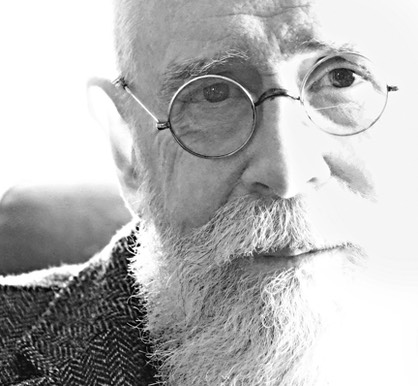
We will be hosting an event with Mark Dunn (local author and musician) who just completed a book on Bruce Cockburn. This event will feature music, some reading from the book, light refreshments, and a special guest joining us virtually… Mr. Bruce Cockburn himself. Tickets for this event are limited.
Bruce Cockburn has enthralled audiences with his insightful lyrics and innovative guitar playing for over half a century. Hit songs like “Wondering Where the Lions Are,” “If I Had a Rocket Launcher,” and “Lovers in a Dangerous Time” are just part of the story. In You Get Bigger as You Go: Bruce Cockburn’s Influence and Evolution, musician and writer M.D. Dunn takes the reader on a humorous and obsessive quest to track Cockburn’s significant cultural footprint. Interviews with producers, musicians, activists, fans, as well as Bruce’s career-long manager, the legendary Bernie Finkelstein, and with the enigmatic Mr. Cockburn himself form the core of this critical assessment and appreciation. In these conversations, Cockburn and friends celebrate a life of music and social engagement.
You Get Bigger as You Go: Bruce Cockburn’s Influence and Evolution is the perfect beginner’s guide to the music and the artist, and a fun addition to any fan's library. Photographs from archivist Daniel Keebler span decades and show Cockburn in his natural habitat, on stage and in the studio.